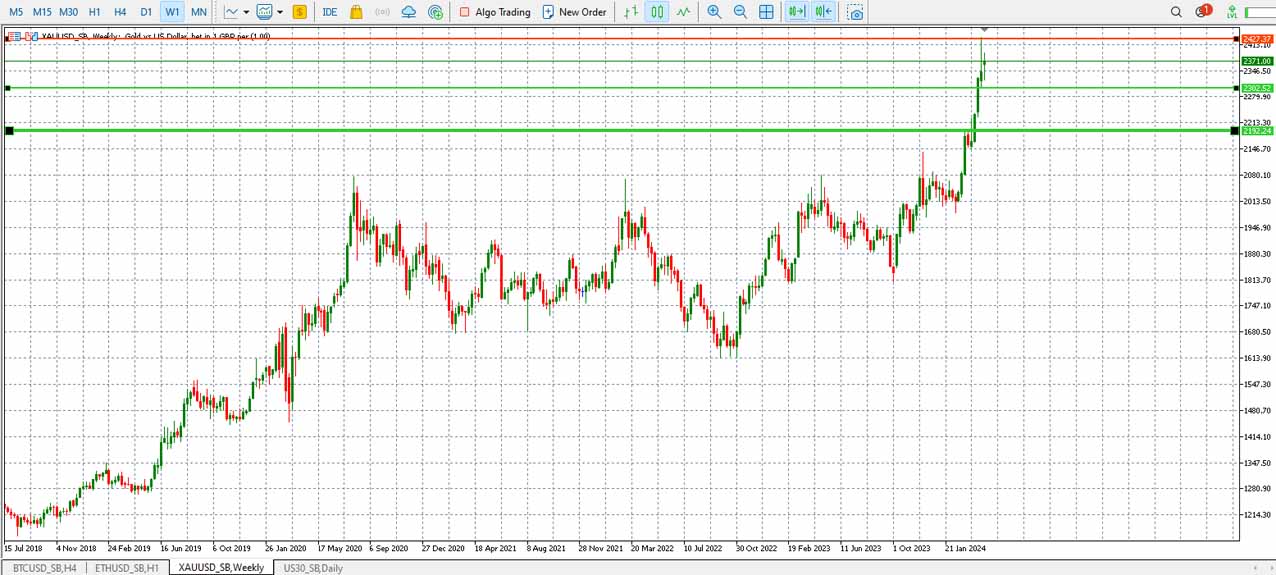By Naeem Aslam
Geopolitical tensions are very much on the minds of every trader, and the sentiment among investors continues to remain cautious.
Israel has vowed to retaliate to last weekend’s Iranian drone attack, but the exact timing of that and the extent of retaliation are very much known.
Some investors and traders believe that the fact that the Israeli government hasn’t responded since the Saturday attack may no longer be on the cards. And the worst-case scenario, which many had initially anticipated, was an all-out war between Israel and Iran.
So far, allies on both sides have called for cool heads, as a much bigger and wider war could easily trigger, given the tensions we’ve already seen between the US and Russia and also between the US and China.
US equity markets
In the equity markets, Monday saw a significant move for one of the leading US indices, the Nasdaq.
The index, which has been leading the rally for a while, fell below its 50-day SMA for the first time since November. The reason that this is significant is that the 50-day SMA is an important support point, and if an index falls below this level, it usually means that there is more sell-off in the store.
As long as the index continues to trade below this important level, it is unlikely for the stock market rally to continue.
Economic data
When it comes to US economic data, most of the important readings that traders pay close attention to are already here.
For instance, in the last few weeks, we have already seen the US CPI inflation and the labour market number.
On Tuesday, we will have the US industrial production m-o-m coming to the spotlight, and the forecast for that reading is 0.4% and 0.1%.
The Fed chairman, Jerome Powell, will also be speaking later in the day, and his comments will be important from two points of view.
Firstly, there is the traditional aspect, and that is what the Federal Reserve’s stance is towards its monetary policy in light of the recent inflation and job data. Secondly, does the Fed have any plans to support the market, if the geopolitical tensions escalate in the Middle East and we see a much wider war?
Oil
Oil prices continue to remain highly interesting, as many traders are still of the mind that a $100 barrel is still very much on the cards.
Traders believe that any tensions that involve Israel in the Middle East could have a detrimental impact on prices. Currently, oil prices have seen a little retracement from their high level; however, the current price trend still indicates that price momentum is strong.
Iran produces more than 3 million barrels of oil per day, and it is an important part of the OPEC group. A full-out war with Israel or any further escalation in tensions could easily push Brent crude prices above the $100 price level. Currently, Brent is trading near the $95 price mark.
Apart from the war, if we look at other factors such as the demand equation and the growth aspects in China, we would see that things do look very different.
For instance, Tuesday saw the Chinese GDP q/y data come to light, and the number has shown that the Chinese economy has picked up its momentum, as the actual number came in at 5.3%, while the forecast was for 4.8%.
This is highly encouraging news, as many traders have been concerned about the growth story in China. Good GDP data means that oil demand will improve, which would have a positive impact on prices.
Gold
The precious metal is the one that needs close attention.
Big numbers have started to flow in the market, and this time these numbers have started to come from Wall Street giants with Citibank, for instance, believing that the gold price, under its current momentum, can touch $3,000.
Gold prices have been very much anchored in place for the past two months for two reasons. Firstly, inflation expectations, and secondly, the ongoing geopolitical tensions.
The fact that the unknown is still unknown when it comes to Israel’s response to Iran’s attack has made traders more nervous. No one really knows how strong or reserved the response would be from Israel, and this means that the odds of much wider events taking place in the Middle East are still on the table.
This particular aspect is keeping traders on edge, and it is more than likely that the prices will continue higher.
Moving away from geopolitical tensions, traders also like the fact that the Chinese GDP has now finally shown that the country’s economic growth is back on track.
China is a serious player when it comes to buying gold, and an improvement in growth means that we could see strong demand for the yellow metal.
In terms of economic events, traders will be watching Jerome Powell’s speech, who is expected to deliver his remarks around 6.15pm GMT.
The Fed already has a clear picture of two things: the US inflation reading and the US labour market. The question is: what will they do with their monetary policy?
The fact that oil prices have serious potential to move higher and Brent crude can go beyond $100 would only provide more tailwind for inflation, an important economic reading that the Fed is trying its best to bring under control.
In terms of Gold, the price is back in positive territory this week after a brief period in negative territory on Monday.
If you look at the weekly chart, the price has already closed in positive territory for the past four consecutive weeks, and it seems likely that the price may touch $2,500 this week, especially if we get more clarity from Israel in terms of a retaliation attack towards Iran.
The current support and resistance zones are shown on the chart below.

Naeem Aslam is Chief Investment Officer at Zaye Capital Markets.
The views and opinions expressed herein are the views and opinions of the author and do not necessarily reflect those of Zaye Capital Markets.







